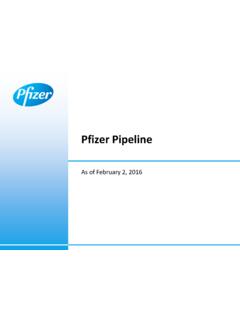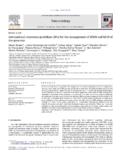Transcription of DRUG NAME: SUNItinib - BC Cancer
1 SUNI tinib DRUG NAME: SUNI tinib SYNONYM(S): SU11248,1 SUNI tinib malate2 COMMON TRADE NAME(S): SUTENT CLASSIFICATION: tyrosine kinase inhibitor Special pediatric considerations are noted when applicable, otherwise adult provisions apply. MECHANISM OF ACTION: SUNI tinib inhibits the phosphorylation of multiple receptor tyrosine kinases (RTKs).2 It is a potent inhibitor of platelet-derived growth factor receptors (PDGFR and PDGFR ), vascular endothelial growth factor receptors (VEGFR1, VEGFR2 and VEGFR3), stem cell factor receptor (KIT), Fms-like tyrosine kinase-3 (FLT-3), colony stimulating factor receptor (CSF-1R), and the glial cell-line derived neurotrophic factor receptor (RET). Consistent with its multi-targeted profile, SUNI tinib may inhibit tumour growth, cause tumour regression, inhibit pathologic angiogenesis, and inhibit metastatic progression of Cancer .
2 PHARMACOKINETICS: Oral Absorption food has no effect on bioavailability cross blood brain barrier? animal studies suggest that SUNI tinib is able to cross the blood brain barrier volume of distribution 2230 L Distribution plasma protein binding 95% (SUNI tinib), 90% (primary active metabolite) hepatic metabolism by CYP3A4 active metabolite(s)1 SU12662 Metabolism inactive metabolite(s) no information found predominantly via feces feces 61% urine 16% terminal half life SUNI tinib; 40-60 h SU12662; 80-110 h Excretion clearance 34-62 L/h Gender no clinically significant differences Elderly no clinically significant differences Ethnicity no clinically significant differences Adapted from standard reference2 unless specified otherwise.
3 USES: Primary uses: Other uses: *Gastrointestinal stromal tumour (GIST) *Renal cell Cancer (RCC) * pancreatic Cancer *Health Canada approved indication BC Cancer Agency Cancer Drug Manual Page 1 of 7 SUNI tinib Developed: January 2007 Revised:1 October 2008; 1 October 2011, 1 December 2013 SUNI tinib SPECIAL PRECAUTIONS: Caution: osteonecrosis of the jaw has been reported with SUNI tinib; patients receiving intravenous bisphosphonates either concurrently or sequentially with SUNI tinib may be at higher risk3-7 pre-existing uncontrolled hypertension, left ventricular dysfunction, or arrhythmias or in patients taking concomitant drugs with arrhythmic potential2 Carcinogenicity: no information found Mutagenicity: SUNI tinib is not mutagenic in the Ames SUNI tinib is not clastogenic in mammalian in vitro or in vivo chromosome Fertility: SUNI tinib may impair fertility in humans.
4 Animal studies have shown ovarian, uterine and vaginal Pregnancy: FDA Pregnancy Category There is positive evidence of human fetal risk, but the benefits from use in pregnant women may be acceptable despite the risk ( , if the drug is needed in a life-threatening situation or for a serious disease for which safer drugs cannot be used or are ineffective). Male contraception is advised, as the drug may be present in the Breastfeeding is not recommended due to the potential secretion into breast milk. SUNI tinib and/or its metabolites are excreted in rat SIDE EFFECTS: The table includes adverse events that presented during drug treatment but may not necessarily have a causal relationship with the drug. Because clinical trials are conducted under very specific conditions, the adverse event rates observed may not reflect the rates observed in clinical practice.
5 Adverse events are generally included if they were reported in more than 1% of patients in the product monograph or pivotal trials, and/or determined to be clinically When placebo-controlled trials are available, adverse events are included if the incidence is > 5% higher in the treatment ORGAN SITE SIDE EFFECT Clinically important side effects are in bold, italics anemia (12-74%, severe 3-14%) leukopenia (14%, severe 6%) lymphopenia (38-59%, severe 0-20%) neutropenia (14-69%, severe 8-14%) blood/bone marrow/ febrile neutropenia thrombocytopenia (14-59%, severe 3-7%) bradycardia (<1%) PR interval prolongation (<1%) cardiovascular (arrhythmia) QT interval prolongation (<1%) hypertension (14-28%, severe 4-6%); see paragraph following Side Effects table left ventricular dysfunction (11-14%, severe 1-2%); see paragraph following Side Effects table cardiovascular (general) myocardial ischemia/infarction (severe 1%)11 constitutional symptoms asthenia (22%, severe 5%) BC Cancer Agency Cancer Drug Manual Page 2 of 7 SUNI tinib Developed: January 2007 Revised:1 October 2008; 1 October 2011, 1 December 2013 SUNI tinib BC Cancer Agency Cancer Drug Manual Page 3 of 7 SUNI tinib Developed: January 2007 Revised:1 October 2008.
6 1 October 2011, 1 December 2013 ORGAN SITE SIDE EFFECT Clinically important side effects are in bold, italics fatigue (42-60%, severe 7-11%) pyrexia (16%, severe 1%) alopecia (5%, severe 0%) bullous lesions (18%)1 dry skin (13%, severe 0%) erythema (12%, severe 0%) hair discolouration (7-14%, severe 0%) hand-foot skin reaction (12-14%, severe 4-5%) rash (15-26%, severe <1%); see paragraph following Side Effects table yellow discolouration of skin (26-32%, severe 0%); see paragraph following Side Effects table dermatology/skin subungal splinter hemorrhages (25%, severe 0%)1 adrenal insufficiency (<1%) hypothyroidism (36%, severe 0%)12; see paragraph following Side Effects table endocrine serum thyroid-stimulating hormone (TSH) abnormality (62%)12 emetogenic potential: rare anorexia (28-31%, severe 1%) constipation (20%, severe 0%) diarrhea (41-49%, severe 3-5%) dyspepsia (15-41%, severe 1%) glossodynia (15%, severe 0%) loss in sensation of taste (20-42%, severe 0%) mucositis/stomatitis (16-41%, severe 1-4%)8 nausea (33-50%, severe 1%) osteonecrosis of the jaw3-5; see Special Precautions section perforation (<1%) gastrointestinal vomiting (25-31%, severe 2%) hemorrhage bleeding (GIST: 20%, severe 7%; RCC: 26%, severe <1%).
7 See paragraph following Side Effects table hepatobiliary/pancreas pancreatitis (severe <1%) infection infections (12%, severe 2%) lymphatics peripheral edema (17%, severe 7%)1,11 elevated alkaline phosphatase (24-55%, severe 2-4%) elevated amylase (17-28%, severe 5%) elevated AST/ALT (39-58%, severe 2-4%) elevated bilirubin (total 12-16%, indirect 10%) metabolic/laboratory elevated lipase (10-50%, severe 10-17%) SUNI tinib BC Cancer Agency Cancer Drug Manual Page 4 of 7 SUNI tinib Developed: January 2007 Revised:1 October 2008; 1 October 2011, 1 December 2013 ORGAN SITE SIDE EFFECT Clinically important side effects are in bold, italics hypoalbuminemia (28%, severe 0%) hypocalcemia (43%, severe <1%), hypercalcemia (11%, severe <1%) hypoglycemia (20%, severe 0%), hyperglycemia (18%, severe 4%) hypokalemia (12%, severe 1%), hyperkalemia (14%, severe 4%) hyponatremia (10%, severe 4%), hypernatremia (10-13%, severe <1%) hypophosphatemia (22%, severe 9%) serum creatine kinase abnormality (39%, severe 1%) serum creatinine abnormality (12-60%, severe 1%) serum uric acid abnormality (49%, severe 15%).
8 Tumour lysis syndrome not reported dizziness (15%) neurology seizures (<1%) increased lacrimation (6%)8 ocular/visual periorbital edema (7%)8 pain pain in extremity (12-18%, severe <1%)11 renal/genitourinary yellow discolouration of urine; associated with yellow discolouration of skin DVT (severe 1-3%)11 vascular pulmonary embolism (severe 1%) Adapted from standard reference2 unless specified otherwise. Hypertension may occur in both GIST and RCC patients receiving Patients should be monitored for hypertension and treated as appropriate with standard antihypertensive therapy. Until more clinical data become available, non-dihydropyridine calcium channel blockers such as diltiazem and verapamil should be avoided, as they are known CYP3A4 inhibitors. Temporary suspension of SUNI tinib is recommended for patients with severe hypertension (> 200 mmHg systolic or > 110 mmHg diastolic).
9 Treatment with SUNI tinib may be resumed once hypertension is controlled. Patients with hypertension that is not controlled by medications should not be treated with SUNI tinib. Left Ventricular Dysfunction, which manifests as a decrease in left ventricular ejection fraction (LVEF), has been reported in up to 14% of patients on Of the patients with treatment-emergent decreases in LVEF, a similar number of patients either recovered without intervention, recovered following intervention (dose reduction or addition of medication), or discontinued SUNI tinib without recovery. A lesser number of patients continued on SUNI tinib without recovery, or died. Patients who present with a recent history of cardiac events ( acute coronary syndrome, arterial bypass graft, symptomatic congestive heart failure (CHF), stroke, or pulmonary embolism) should be monitored for clinical signs and symptoms of CHF, and evaluated for decreased LVEF while receiving SUNI tinib.
10 In patients with LVEF < 50% and > 20% below baseline, the dose of SUNI tinib should be interrupted and/or reduced regardless of clinical evidence of CHF. In the presence of clinical manifestations of CHF, discontinuation of SUNI tinib is recommended. Hypothyroidism has been reported in patients receiving SUNI tinib. Abnormal TSH concentrations have been documented in 62% of patients. Persistent primary hypothyroidism developed in 36% of patients after a range of 12 to 94 weeks of SUNI tinib Eighteen percent of patients taking SUNI tinib for 36 weeks developed hypothyroidism, 29% of patients taking SUNI tinib for one year were affected, and 90% of patients treated for more than 96 weeks developed increased TSH levels. The incidence of hypothyroidism appears to increase progressively with the duration of SUNI tinib therapy.














